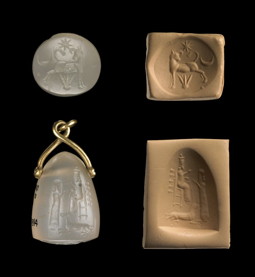Gula/Ninkarrak (goddess)
Gula/Ninkarrak is a healing deity also known as Ninisinna, "Lady of Isin".
Functions

Neo-Assyrian stamp seal showing the goddess Gula sitting on a throne that rests on a dog (BM ME 130814). © The British Museum. View image on the British Museum's website.
Typically encountered in medical incantations as bēlet balāti, "Lady of Health", Gula/Ninkarrak was also known as the azugallatu the "great healer", an epithet she shared with her son Damu. Other epithets, such as the "great healer of the land" and "great healer of the black-headed ones", point to her wide-reaching 'national' significance. Gula/Ninkarrak was also credited as an "herb grower", "the lady who makes the broken up whole again", and "creates life in the land", indicative of an aspect as a vegetation/fertility goddess with regenerative powers. At least in the Neo-Babylonian period, she also seems to have had an oneiric quality, being sought in incubation dreams (Reiner 1960a: 24) and appearing in nocturnal visions (Al-Rawi 1990). Gula/Ninkarrak also had a violent side as the "queen whose 'tempest', like a raging storm, makes heaven [tremble (?)], makes earth quake" (Avalos 1995: 106-7). The goddess and her dogs were frequently mentioned in curse formulae.
Divine Genealogy and Syncretisms
She is the daughter of Anu and wife of the various incarnations of the warrior god Pabilsag (in Isin), Ninurta (in Nippur) and Ningirsu (in Lagaš) (Lambert 1967: 10); and mother of three other healing deities: Damu, Ninazu and Gunurra. Relatively minor goddesses such as Nintinugga, Meme and Baba are also identified with Gula/Ninkarrak. In the Old Babylonian Period, several goddesses are syncretised with Gula, thereby becoming healing goddesses (see Baba and Ninisinna (Richter 2004: 195).
Cult Place(s)
The most prominent cult centre of Gula/Ninkarrak(/Ninisinna) was Isin [~/images/Isin.jpg], where her temple as named é-u-gi7-ra, "Dog Temple" (Shaffer 1974: 252). Nippur [~/images/Nippur.jpg] was another significant centre, where the earliest excavated levels of the Neo-Babylonian temple of Gula/Ninkarrak are dated to the Isin-Larsa period and presumably lie on earlier incarnations from ca. 3000 BCE. The major period of construction belongs to the Kassite period (Gibson 1990). Other cult centres include Umma [~/images/Umma.jpg], Lagaš [~/images/Lagash.jpg], Larsa [~/images/Larsa.jpg], Uruk [~/images/Uruk.jpg], Borsippa [~/images/Borsippa.jpg], Babylon [~/images/Babylon.jpg] and Assur [~/images/Assur.jpg], the latter three each boasting 3 temples dedicated to the goddess (Frankena 1957-71b: 696). Texts make no reference to temples of Gula/Ninkarrak serving for the on-site treatment of patients (Avalos 1995). Peculiar to the petitionary and thanksgiving function of the temples of Gula/Ninkarrak (Avalos 1995) are the terracotta votive figurines of humans holding various body parts (indicating the source of ailment for which the aid of the goddess was sought/received); and those of dogs, sacred animals of Gula/Ninkarrak (Gibson 1990). Dog figurines were often inscribed with a dedication or prayer to the goddess. Particularly notable in Isin [~/images/Isin.jpg] are the more than 30 dog burials discovered below the ramp leading to the temple (Wapnish and Hesse 1993: 69ff).
Time Periods Attested
Gula/Ninkarrak's earliest attestation dates to the Ur III Period (Frankena 1957-71b: 695). She has a conspicuous rise in popularity in the second half of the second millennium during the Kassite period; and her cult continues well into the first millennium.
Iconography
Gula/Ninkarrak's attribute animal was the dog, both in iconography as well as in texts. Representations of Gula/Ninkarrak as a seated figure with a dog reclining at her feet emerge in the Old Babylonian period and can be seen on terracotta plaques (Barrelet 1968). The same motif is particularly popular on Kassite kudurrus TT (Seidl 1989) and Neo-Assyrian/Babylonian cylinder seals TT (Frankena 1957-71b: 697).
Name and Spellings
The meaning of Gula's name is unclear, although the ancients created a folk etymology of this name based on the Sumerian word for 'great' (gu-la) (Frankena 1957-71b: 695). Ninkarrak's name likely means 'Lady of Kar' (not 'Lady of Karrak') (Kraus 1951: 69).
- Written forms:
- dgu-la, dgú-la, dgú-lá, dME.ME (logographic); dnin-kar-ra-ak, dnin-kar-ra-ak-a
- Normalised forms:
- Gula; Ninkarrak
Gula in Online Corpora
- The Cuneiform Digital Library Initiative
- The Electronic Text Corpus of Sumerian Literature
- The Corpus of Ancient Mesopotamian Scholarship [http://oracc.museum.upenn.edu/cams/gkab/qpn-x-divine?gula]
Ninkarrak in Online Corpora
Further Reading
- Al-Rawi 1990, "Tablets from the Sippar Library, I".
- Avalos 1995, Illness and Healthcare in the Ancient Near East.
- Barrelet 1968, Figurines et reliefs en terre cuite.
- Frankena 1957-71b, "Gula."
- Gibson 1990, "Nippur, 1990".
- Lambert 1967. "The Gula Hymn of Bullutṣa-rabi".
- Munn-Rankin 1959, "Ancient Near Eastern seals".
- Postgate 1994, "Text and figure in ancient Mesopotamia".
- Reiner 1960a, "Fortune-telling in Mesopotamia".
- Shaffer 1974, "Enlilbani and the 'Dog House'".
- Seidl 1989, Die Babylonischen Kudurru-Reliefs.
- Wapnish and Hesse 1993, "Pampered pooches or plain pariahs?".
Yaǧmur Heffron
Yaǧmur Heffron, 'Gula/Ninkarrak (goddess)', Ancient Mesopotamian Gods and Goddesses, Oracc and the UK Higher Education Academy, 2019 [http://oracc.museum.upenn.edu/amgg/listofdeities/gulaninkarrak/]